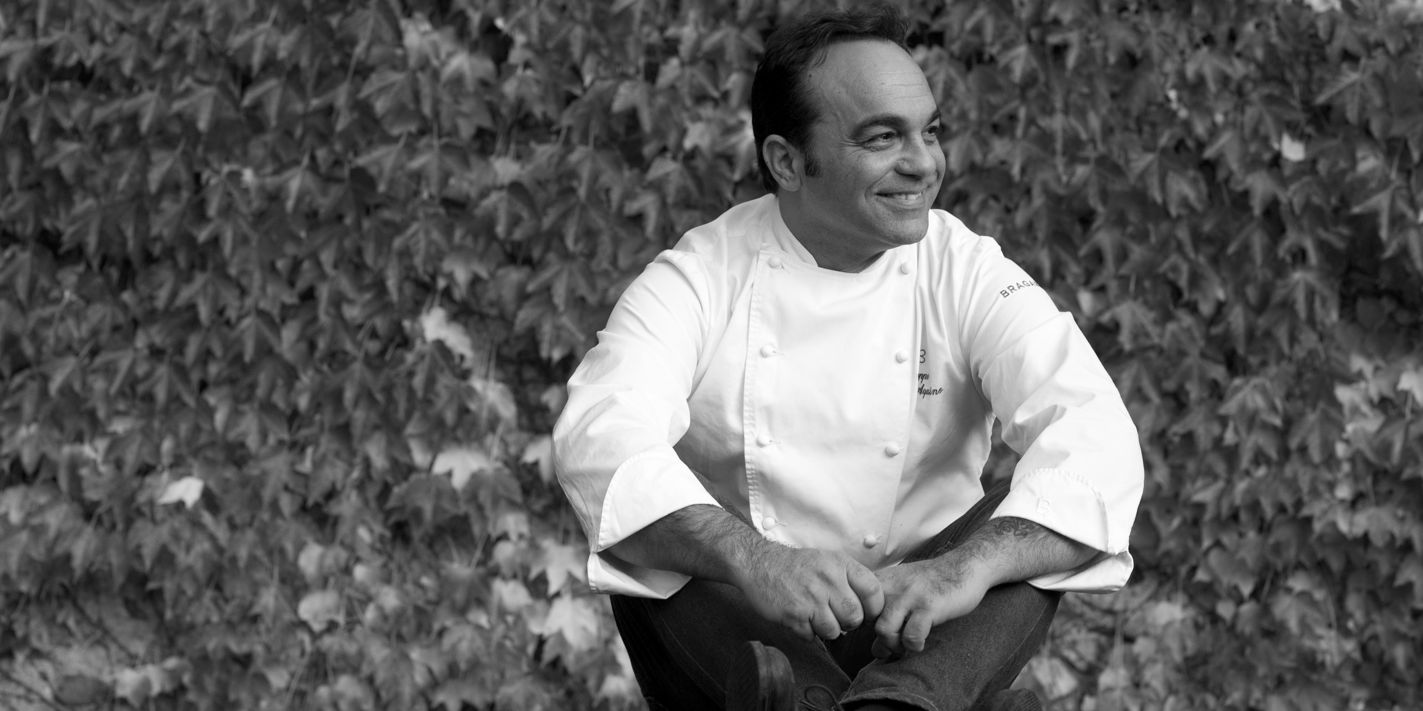Giuseppe D'Aquino

Giuseppe D'Aquino
By giving up on a promising career as an engineer and following his dream of becoming a chef, Giuseppe D'Aquino took a huge gamble. One Michelin star later, that gamble seems to have paid off. He uses ingredients and takes inspiration from all over Italy at his Ristorante Oseleta, nestled in the hills above Lake Garda.
A lot of chefs go to catering college because they’re fed up with academic studying; it either proves too hard, not interesting enough or simply boring for those who then go on to achieve greatness in the kitchen. Naples-born Giuseppe D’Aquino, however, came from a family of doctors, excelled at school and was on the right track to becoming an engineer. But after receiving a diploma at a technical college, he knew it wasn’t the life for him. ‘I realised it was not what I wanted to do and that I wanted to be a chef,’ he says. ‘I told my father who, like a good Neapolitan, told me I could either choose to be safe or stupid.’
Giuseppe had always loved cooking throughout his childhood. ‘As a boy, when I came back after an evening with friends I started making myself a simple sandwich or croissant,’ he explains. ‘But I started wanting more; I would cook anything and everything, from sauces to risottos. I remember my mother waking up in the morning and being distraught at all the dirty dishes and pans in the kitchen – but it was an indicator of my passion.’
When he finally decided to go against his family’s wishes to become an engineer, Giuseppe’s first few jobs were in small kitchens up and down the Amalfi coast. But it wasn’t until he moved to Paris when he was nineteen that he realised he’d done the right thing. He ended up working in the city for ten years, in restaurants such as the three-starred Senderens and as a sous chef at the Hôtel de Ville, the city’s local administration building. His time with the chefs there – whom he says were regarded in a light similar to lawyers and doctors – helped him to become the chef he’d always dreamed of being, and he began to develop his own style.
After a brief stint in Geneva and taking some time to complete some internships and cooking diplomas, Giuseppe was called back to Paris to take over from the head chef at the Hôtel de Ville. He then worked for a year in the Maldives and eventually found his way to Dubai, where he worked for three years as an executive chef for four restaurants, covering Italian, French, international and Arabian cuisine. But Giuseppe eventually found himself looking for a new challenge. ‘I came back home to see if I could stand up against other Italian chefs – it’s quite easy for someone coming from Italy to work abroad and be considered a good chef,’ he says. ‘I found a position at the Villa Mangiacane in San Casciano, and worked there for two and a half years.’ Afterwards, Giuseppe worked as a consultant for another hotel in the area, before deciding to build his own restaurant from the ground up in the hills of Lake Garda, near Verona, with the support of his family.
Giuseppe opened Ristorante Oseleta at the Villa Cordevigo Wine Relais, an eighteenth century Venetian villa with formal Italian gardens and its own olive groves and woods. In 2013, it received a Michelin star, thanks to the beautiful setting, attentive service and dishes which take inspiration from all the different regions of Italy. Instead of restricting what he can use to the surrounding area, Giuseppe uses ingredients from all over the country in his recipes. ‘When I used to work abroad, any Italian ingredients I could get my hands on were like gold dust,’ he tells us. ‘Nothing is as good as Italian ingredients, and now that I have every single one available to me in less than ten hours, why would I limit myself? I can have shrimp from Mazara del Vallo and buffalo mozzarella from Fassona in Piedmont sent to me within the same day. I don’t think being influenced from lots of different places is a bad thing.’
It certainly seems to be ingredients that drive Giuseppe’s food – particularly those from his childhood. ‘I love Piennolo tomatoes that grow on the slopes of Vesuvius,’ he explains. ‘In my house we kept them hanging on the balcony and ate them with hard bread soaked in water – it was fantastic. It’s an incredibly Mediterranean ingredient and I use it at the restaurant when ever I can. We are in the hills of Lake Garda and get customers from all over Germany, the Netherlands and the UK. If you’re in Greece, you eat moussaka. If you’re in Spain, you eat paella. In Italy, people want to eat pizza or pasta with tomato sauce. We try to make the sauce the way God intended, using Gragnano paste and Piennolo tomatoes.’


